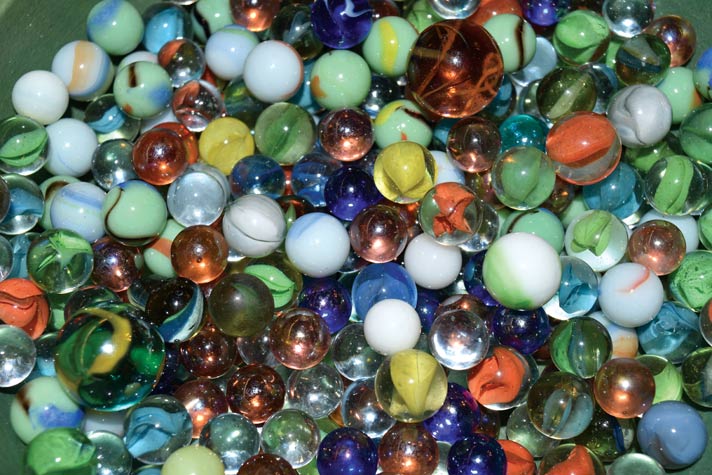Speaking of Antiquing – September 2016
Marble collecting can be fun, interesting and exciting. Generally, you wouldn’t think too much about a bag of random marbles found at a thrift shop or garage sale until you look more closely beyond the common cat’s eyes, the clearies, the swirls, and the shooters, and see how they are made.
Are they opaque or translucent? Is there one color or three, perhaps four? Is there a stripe or lattice pattern? Does the design swirl left or right?
These are questions marble collectors ask all the time of these simple glass balls. Answers are not so simple, and some marbles can be worth thousands of dollars.
Marbles have been made from a variety of materials including, agate, alabaster, limestone, flint, semiprecious stone, fired and unfired clay, glass, and steel. Most collectors agree that glass marbles are indeed the most popular.
Marbles originated with the Dutch who ground stone such as limestone into hard spheres. Games of marbles were traced back to the mid 1500’s, where marbles got their name from ones actually made of marble.
Handmade blown glass spheres with multiple colors and designs were made by the thousands using slag glass from art glass companies. The same company that made your grandmother’s wine glasses or crystal pieces also made marbles for children. The quality of the glass made the colors more vivid, and gave the sphere a hardness that could withstand the impact that a game of marbles put them through. The colors used in making marbles varied with whatever the company was making at the time. Some companies made marble-making into an art form, not just a way to use-up leftover glass.
The credit for the artistry of glass marble-making really should go to Germany, which was making them since the early 1800’s, perfecting techniques of design, creating dimensions and beauty. German marbles have a solid core, Latticino core, Ribbon core, or a complex core, in which two or more variations are used within the same marble. Transparent swirl marbles, using many colors created a mesmerizing effect as the ribbons of color appeared to have no beginning or end. Swirl marbles were nicknamed by their color combinations or stripe size. Gold was sometimes added, as well as copper, to create sparkle. Corkscrew machine-made marbles were made by using two or more colors with the colors swirled together. The colors start at one place on the marble and run around it at least one time, completely, without touching or crossing.
Children of all ages spent many hours playing marbles in the dirt, inventing game variations as collections of the tiny orbs passed from winner to winner. Adults played a version of lawn bowling on beautiful Victorian carpets with slightly larger glass balls, and they had their own set of rules.
One would need to be deeply immersed in the marble world to really know the “how’s” and “what’s” of marble collecting.
There are lifelong marble collectors who have just scratched the surface of the beautiful little orbs, so do not feel intimidated to jump in and begin collecting.

 Margaret Barns is co-owner of Pickety Place Antiques & Collectibles located at 130 N. 4th Street in Jacksonville. LIKE them on
Margaret Barns is co-owner of Pickety Place Antiques & Collectibles located at 130 N. 4th Street in Jacksonville. LIKE them on